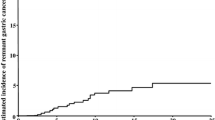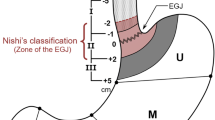Abstract
Background
Carcinoma arising in the cardioesophageal junction is a distinct clinical entity compared with tumors located in other regions of the stomach. The prognosis for adenocarcinoma of the upper stomach is considered to be relatively poorer than carcinomas of the more distal stomach. We have therefore investigated patients with carcinoma of the gastric cardia in order to evaluate the underlying cause of this poor prognosis.
Materials and Methods
Clinicopathologic features and postoperative prognosis of 101 patients with carcinoma of the cardia were evaluated and compared with findings on 1884 patients with tumors in other regions of the stomach.
Results
Tumors of the cardia had a mean size of 6.8 cm, which was significantly larger than the mean size of 5.9 cm for tumors found in the middle- and lower third of the stomach. The incidence of serosal invasion, lymph node metastasis, and lymphatic and blood vessel invasion was higher in association with adenocarcinoma of the cardia than with adenocarcinoma in remaining parts of the stomach. In the analysis of patients who had undergone curative resection, the 5-year survival rates were 61.6, 79.1, and 82.6% in patients with carcinoma of the cardia, upper one-third, and remaining middle- and lower one-third of the stomach, respectively, and the differences were statistically significant. Multivariate analysis indicated that adenocarcinoma of the gastric cardia is an independent prognostic factor. With regard to the site of recurrence, both lymph node and hematogenous recurrence were observed more frequently in the cardia than in the remaining parts of the stomach.
Conclusions
Our data indicate that the prognosis of patients with adenocarcinoma of the gastric cardia is extremely poor. To improve their prognosis, new treatments in addition to gastrectomy with extensive lymph node dissection are needed.



Similar content being viewed by others
References
Devesa SS, Blot WJ, Fraumeni JF Jr. Changing patterns in the incidence of esophageal and gastric carcinoma in the United States. Cancer 1998;83:2049–2053
Siewert JR, Stein HJ. Classification of adenocarcinoma of the oesophagogastric junction. Br J Surg 1998;85:1457–1459
Ohno S, Tomisaki S, Oiwa H, et al. Clinicopathologic characteristics and outcome of adenocarcinoma of the human gastric cardia in comparison with carcinoma of other regions of the stomach. J Am Coll Surg 1995;180:577–582
Japanese Gastric Cancer Association: Japanese Classification of Gastric Carcinoma. Tokyo, Kanehara, 1999
Stipa S, Di Giorgio A, Ferri M. Surgical treatment of adenocarcinoma of the cardia. Surgery 1992;111:386–393
Makela JT, Juvonen T, Laitinen S, et al. Adenocarcinoma of the gastric cardia. Surg Oncol 1995;4:75–81
Blomjous JG, Hop WC, Langenhorst BL, et al. Adenocarcinoma of the gastric cardia. Recurrence and survival after resection. Cancer 1992;70:569–574
Kajiyama Y, Tsurumaru M, Udagawa H, et al. Prognostic factors in adenocarcinoma of the gastric cardia: pathologic stage analysis and multivariate regression analysis. J Clin Oncol 1997;15:2015–2021
Johnson H, Belluco C, Masood S, et al. Preoperative factors of prognostic significance in gastric cancer. J Natl Med Assoc 1995;87:423–426
Wang LD, Shi ST, Zhou Q, et al. Changes in p53 and cyclin D1 protein levels and cell proliferation in different stages of human esophageal and gastric-cardia carcinogenesis. Int J Cancer 1994;59:514–519
Saito H, Tsujitani S, Kondo A, et al. Expression of vascular endothelial growth factor correlates with hematogenous recurrence in gastric carcinoma. Surgery 1999;125:195–201
Sakamoto Y, Ohyama S, Yamamoto J, et al. Surgical resection of liver metastases of gastric cancer: an analysis of a 17-year experience with 22 patients. Surgery 2003;133:507–511
Aikou T, Shimazu H. Difference in main lymphatic pathways from the lower esophagus and gastric cardia. Jpn J Surg 1989;19:290–295
Rudiger Siewert J, Feith M, Werner M, et al. Adenocarcinoma of the esophagogastric junction: results of surgical therapy based on anatomical/topographic classification in 1,002 consecutive patients. Ann Surg 2000;232:353–361
Author information
Authors and Affiliations
Corresponding author
Rights and permissions
About this article
Cite this article
Saito, H., Fukumoto, Y., Osaki, T. et al. Distinct Recurrence Pattern and Outcome of Adenocarcinoma of the Gastric Cardia in Comparison with Carcinoma of Other Regions of the Stomach. World J. Surg. 30, 1864–1869 (2006). https://doi.org/10.1007/s00268-005-0582-z
Published:
Issue Date:
DOI: https://doi.org/10.1007/s00268-005-0582-z




